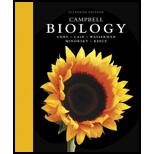
Concept explainers
What does it mean wheti we say that the two DNA strands in the double helix are antiparallel? What would an end of the double helix look like if the strands were parallel?
To explain: The meaning of the statement “the two strands in the double helix DNA are antiparallel”.
Introduction: DNA is a double-stranded molecule that consists of two strands of nucleotides. The bases in one strand are complementary to the bases on the other strand. During DNA replication, the two strands of parent DNA molecule separate. The parent strands act as templates along which the DNA polymerases add up the complementary base pairs in the context of base-pairing rules.
Explanation of Solution
A deoxyribonucleic acid (DNA) molecule consists of two polynucleotide chains that associate as a double helix structure. The polarity in the DNA chain is referred to as 5ʹ end and the other as 3ʹ end. One end of DNA consists of a phosphate attached to a 5ʹ deoxyribose carbon (5ʹ end), and the other end has a hydroxyl group that is attached to a 3ʹ deoxyribose carbon (3ʹ end). The nucleotides are linked by phosphodiester bonds through 5ʹ-P of one sugar and 3ʹ-OH group of the next sugar. In a double-stranded DNA, one strand is “complemented” by the other strand. If one DNA strand runs in the 5ʹ→3ʹ direction, its complementary strand would run in the 3ʹ→5ʹ direction. Thus, the two strands are antiparallel to each other.
To determine: The ends of a double helix DNA if the two DNA strands in the double helix were parallel.
Introduction: DNA or deoxyribonucleic acid carries hereditary information from one generation to another. DNA replication is a process that takes place in every biological cell. It involves the coping and producing of two identical copies of a cell from their parent DNA molecule.
Explanation of Solution
If two DNA strands run in parallel directions, they would run in the same direction, that is, they would both run in the 5′→3′ direction. In such a condition, in the same side, an end of the DNA molecule would have two 5′ ends and two 3′ ends.
Want to see more full solutions like this?
Chapter 16 Solutions
Campbell Biology (11th Edition)
Additional Science Textbook Solutions
Applications and Investigations in Earth Science (9th Edition)
College Physics: A Strategic Approach (3rd Edition)
Laboratory Manual For Human Anatomy & Physiology
SEELEY'S ANATOMY+PHYSIOLOGY
Biology: Life on Earth with Physiology (11th Edition)
Chemistry: A Molecular Approach (4th Edition)
- In one paragraph show how atoms and they're structure are related to the structure of dna and proteins. Talk about what atoms are. what they're made of, why chemical bonding is important to DNA?arrow_forwardWhat are the structure and properties of atoms and chemical bonds (especially how they relate to DNA and proteins).arrow_forwardThe Sentinel Cell: Nature’s Answer to Cancer?arrow_forward
- Molecular Biology Question You are working to characterize a novel protein in mice. Analysis shows that high levels of the primary transcript that codes for this protein are found in tissue from the brain, muscle, liver, and pancreas. However, an antibody that recognizes the C-terminal portion of the protein indicates that the protein is present in brain, muscle, and liver, but not in the pancreas. What is the most likely explanation for this result?arrow_forwardMolecular Biology Explain/discuss how “slow stop” and “quick/fast stop” mutants wereused to identify different protein involved in DNA replication in E. coli.arrow_forwardMolecular Biology Question A gene that codes for a protein was removed from a eukaryotic cell and inserted into a prokaryotic cell. Although the gene was successfully transcribed and translated, it produced a different protein than it produced in the eukaryotic cell. What is the most likely explanation?arrow_forward
- Molecular Biology LIST three characteristics of origins of replicationarrow_forwardMolecular Biology Question Please help. Thank you For E coli DNA polymerase III, give the structure and function of the b-clamp sub-complex. Describe how the structure of this sub-complex is important for it’s function.arrow_forwardMolecular Biology LIST three characteristics of DNA Polymerasesarrow_forward

 Human Heredity: Principles and Issues (MindTap Co...BiologyISBN:9781305251052Author:Michael CummingsPublisher:Cengage Learning
Human Heredity: Principles and Issues (MindTap Co...BiologyISBN:9781305251052Author:Michael CummingsPublisher:Cengage Learning Biology Today and Tomorrow without Physiology (Mi...BiologyISBN:9781305117396Author:Cecie Starr, Christine Evers, Lisa StarrPublisher:Cengage Learning
Biology Today and Tomorrow without Physiology (Mi...BiologyISBN:9781305117396Author:Cecie Starr, Christine Evers, Lisa StarrPublisher:Cengage Learning Biology: The Dynamic Science (MindTap Course List)BiologyISBN:9781305389892Author:Peter J. Russell, Paul E. Hertz, Beverly McMillanPublisher:Cengage Learning
Biology: The Dynamic Science (MindTap Course List)BiologyISBN:9781305389892Author:Peter J. Russell, Paul E. Hertz, Beverly McMillanPublisher:Cengage Learning BiochemistryBiochemistryISBN:9781305577206Author:Reginald H. Garrett, Charles M. GrishamPublisher:Cengage Learning
BiochemistryBiochemistryISBN:9781305577206Author:Reginald H. Garrett, Charles M. GrishamPublisher:Cengage Learning Biology 2eBiologyISBN:9781947172517Author:Matthew Douglas, Jung Choi, Mary Ann ClarkPublisher:OpenStax
Biology 2eBiologyISBN:9781947172517Author:Matthew Douglas, Jung Choi, Mary Ann ClarkPublisher:OpenStax





